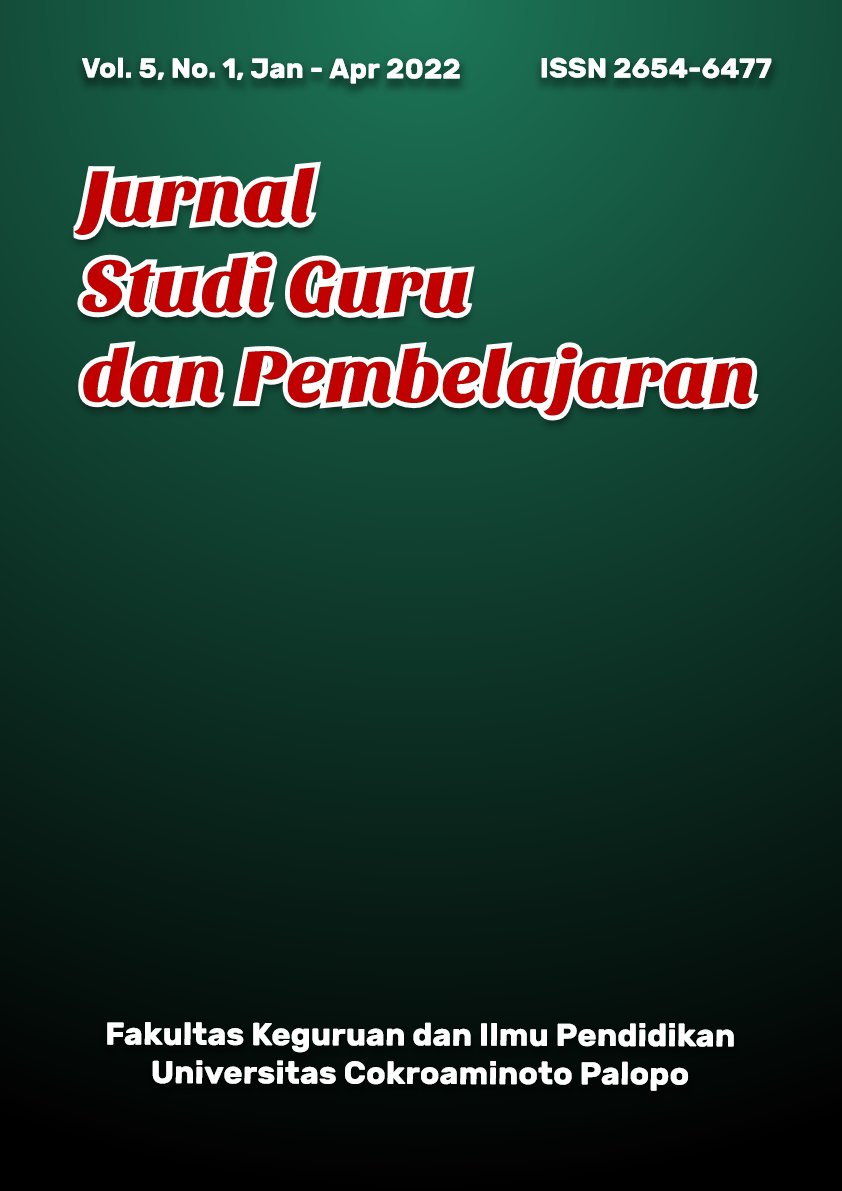Using Audio Visual Media to Improve English Learning Outcomes
DOI:
https://doi.org/10.30605/jsgp.5.1.2022.1297Keywords:
Audio Visual, English, Online LearningAbstract
Video recordings, slides, and sound are examples of audio-visual media. It is thought that learning to use audio visuals in English lessons will help students better understand the problems or lessons presented. Because listeners are encouraged to use their imagination and optimize their left and right brain function. Audio-visual media in the form of animated learning videos and power points are used in English subjects at SMK Grafika that are conducted online or online. The purpose of this study was to see if audio visuals could boost students' motivation and enthusiasm for learning during online classes.
Downloads
References
Anderson, T. (2004). Teaching in an online learning context. Theory and Practice of Online Learning, 273.
Anderson, T. (2008). The theory and practice of online learning. Athabasca University Press.
Baeten, M., Kyndt, E., Struyven, K., & Dochy, F. (2010). Using student-centered learning environments to stimulate deep approaches to learning: Factors encouraging or discouraging their effectiveness. Educational Research Review, 5(3), 243–260. DOI: https://doi.org/10.1016/j.edurev.2010.06.001
Berkwits, M., & Inui, T. S. (1998). Making use of qualitative research techniques. Journal of General Internal Medicine, 13(3), 195. DOI: https://doi.org/10.1046/j.1525-1497.1998.00054.x
Deci, E. L., Vallerand, R. J., Pelletier, L. G., & Ryan, R. M. (1991). Motivation and education: The self-determination perspective. Educational Psychologist, 26(3–4), 325–346. DOI: https://doi.org/10.1080/00461520.1991.9653137
Fahy, P. J. (2004). Media characteristics and online learning technology. Athabasca University Press.
Garris, R., Ahlers, R., & Driskell, J. E. (2002). Games, motivation, and learning: A research and practice model. Simulation & Gaming, 33(4), 441–467. DOI: https://doi.org/10.1177/1046878102238607
Greenhow, C., & Lewin, C. (2016). Social media and education: Reconceptualizing the boundaries of formal and informal learning. Learning, Media and Technology, 41(1), 6–30. DOI: https://doi.org/10.1080/17439884.2015.1064954
Hanrahan, M. (1998). The effect of learning environment factors on students’ motivation and learning. International Journal of Science Education, 20(6), 737–753. DOI: https://doi.org/10.1080/0950069980200609
Harlen, W. (2006). The role of assessment in developing motivation for learning. Assessment and Learning, 61–80.
Huang, T.-H., Liu, Y.-C., & Shiu, C.-Y. (2008). Construction oHuang, T.-H., Liu, Y.-C., & Shiu, C.-Y. (2008). Construction of an online learning system for decimal numbers through the use of cognitive conflict strategy. Computers & Education, 50(1), 61–76.f an online learning system for decimal numbers. Computers & Education, 50(1), 61–76. DOI: https://doi.org/10.1016/j.compedu.2006.03.007
Kinchin, I. M., Hay, D. B., & Adams, A. (2000). How a qualitative approach to concept map analysis can be used to aid learning by illustrating patterns of conceptual development. Educational Research, 42(1), 43–57. DOI: https://doi.org/10.1080/001318800363908
Mashudi, M., Komariah, K., & Irvan, F. (2021). The use of audio-visual media in improving Culinary students learning outcomes in Chicken Carcass material. Jurnal Pendidikan Vokasi, 11(1). DOI: https://doi.org/10.21831/jpv.v11i1.36439
Octaviyantari, N. L. A., Suarni, N. K., & Widiana, I. W. (2020). Improving Social Studies Learning Outcomes Through Group Investigation Learning Model Assisted with Audio-Visual Media. Journal of Education Technology, 4(3), 349-358. DOI: https://doi.org/10.23887/jet.v4i3.25245
Olagbaju, O. O., & Popoola, A. G. (2020). Effects of Audio-Visual Social Media Resources-Supported Instruction on Learning Outcomes in Reading. International Journal of Technology in Education, 3(2), 92-104. DOI: https://doi.org/10.46328/ijte.v3i2.26
Syofiarti, S., Saputra, R., Lahmi, A., & Rahmi, R. (2021). The Use of Audiovisual Media in Learning and Its Impact on Learning Outcomes of Islamic Cultural History at Madrasah Tsanawiyah Negeri 4 Pasaman. Firdaus Journal, 1(1), 36-44.
Tapilouw, F., & Setiawan, W. (2008). Meningkatkan pemahaman dan retensi siswa melalui pembelajaran berbasis teknologi multimedia interaktif. Jurnal Pendidikan Teknologi Informasi Dan Komunikasi, 1(2), 19–25.
Willett, R. (2007). Technology, pedagogy and digital production: A case study of children learning new media skills. Learning, Media and Technology, 32(2), 167–181. DOI: https://doi.org/10.1080/17439880701343352
Winarto, W., Syahid, A., & Saguni, F. (2020). Effectiveness of the use of audio visual media in teaching islamic religious education. International Journal of Contemporary Islamic Education, 2(1), 81-107. DOI: https://doi.org/10.24239/ijcied.Vol2.Iss1.14
Downloads
Published
How to Cite
Issue
Section
License
In submitting the manuscript to the journal, the authors certify that:
- They are authorized by their co-authors to enter into these arrangements.
- The work described has not been formally published before, except in the form of an abstract or as part of a published lecture, review, thesis, or overlay journal.
- That it is not under consideration for publication elsewhere,
- That its publication has been approved by all the author(s) and by the responsible authorities – tacitly or explicitly – of the institutes where the work has been carried out.
- They secure the right to reproduce any material that has already been published or copyrighted elsewhere.
- They agree to the following license and copyright agreement.
License and Copyright Agreement
Authors who publish with JSGP agree to the following terms:
- Authors retain copyright and grant the journal right of first publication with the work simultaneously licensed under Creative Commons Attribution License (CC BY-SA 4.0) that allows others to share the work with an acknowledgement of the work's authorship and initial publication in this journal.
- Authors are able to enter into separate, additional contractual arrangements for the non-exclusive distribution of the journal's published version of the work (e.g., post it to an institutional repository or publish it in a book), with an acknowledgement of its initial publication in this journal.
- Authors are permitted and encouraged to post their work online (e.g., in institutional repositories or on their website) prior to and during the submission process, as it can lead to productive exchanges, as well as earlier and greater citation of published work.














